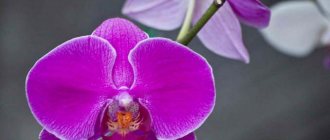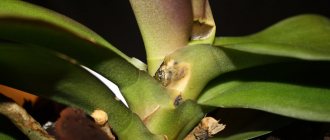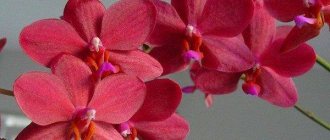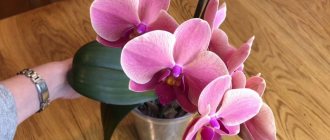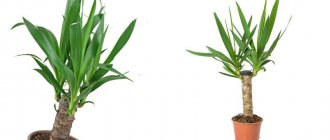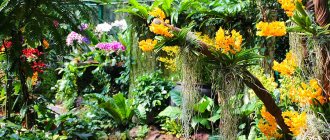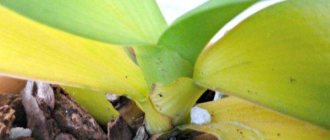The plant is a selection hybrid. The flower is popularly called “star” because of the corresponding shape of the inflorescences. It is easy to care for, so beginners in gardening buy and grow it. It can often be found in institutions, clinics or schools.
Author of the article
Maxim Sverchkov
Professional biologist and breeder with extensive experience and experience.
Origin and description of the Cumbrian orchid
The Cambria orchid is not a single species of plant. The name is rather a commercial one, uniting hybrid species, in the creation of which three or more genera of the oncidium group were used. Nevertheless, each flower has its own name - for example, the name of the scientist who created this or that hybrid.
Cumbria's orchids are stunning in their beauty and diversity
A common feature of hybrids is the sympodial (shoot) type of growth. Cambria has oval, round or ovoid pseudobulbs. They are also called false bulbs. Their main task is to accumulate nutrients to help the plant survive extreme conditions. The more false bulbs, the healthier the Cambria and the more luxuriant the flowering.
Each pseudobulb produces up to 3 leaves. They are painted dark green, narrow and long in shape - up to 50 cm. The central vein is clearly defined.
Unlike other orchids, which have a powerful root system that can hold the plant on the carrier, Cambria's roots are very thin and easily vulnerable.
Cambria is capable of throwing out several flower stalks at the same time. There are dozens of buds on one flower arrow. They are not all revealed at once. The sizes of flowers, varied in shape, range from 5 to 10 cm. They can be white, yellow, burgundy, cream, pink. As a rule, Cumbrias bloom several times a year.
Cambria blooms several times a year
Such plants are not found in nature. They were created exclusively for indoor floriculture. Cumbrias are unpretentious and adapt well to environmental conditions. These are perhaps the most undemanding representatives of the Orchid family. Therefore, for beginning gardeners who are in love with orchids, Cambria is an ideal option.
When buying Cambria in a store, choose a specimen with several pseudobulbs. A plant with one false bulb is usually not viable.
Hybrid species
- Colmanara is a hybrid of Miltonia, Odontoglossum and Oncidium. A long vertical peduncle, appearing at the moment of ripening of a young false bulb, is crowned with 5 or 20 flowers. The colors are dominated by yellow and red. Flowering duration is up to 8 weeks. Popular varieties: Wildcat Bobcat, Wildcat.
- Vuilstekeara is a hybrid bred by crossing Odontoglossum, Cochlyodes and Miltonia. On long and graceful peduncles there are from 5 to 20 flowers, mainly in pink, yellow or red. The flowering period is from late winter to early summer. Duration - up to 2 months. The species is represented by numerous varieties, including: Linda Isler “Red”, Yokara Perfection, Melissa Brianne “Kai, s Choice”.
- Burrageara is a complex hydride, the parent forms of which were Miltonia, Cochlioda, Odontoglossum and Oncidium. It is distinguished by its sophistication: several flowers are collected in inflorescences. The coloration is dominated by combinations of yellow and red tones. Flowering occurs in winter. The smell of such an orchid is reminiscent of a rose. Varieties: Stefan Isler, Stefan Isler “Living Fire”, Nellie Isler “Swiss Beauty”.
- Beallara is a complex hybrid obtained by crossing 4 species: Brassia, Miltonia, Odontoglossum and Cochlioda. The flowering period falls in the middle - end of summer. The graceful flowers are cream-colored with dark spots or white-pink-purple shades. Among the large number of varieties, the following stand out: Peggy Ruth Carpenter “Morning Joy”, Marfitch Howard, s Dream, Tahoma Glacier “Ethan”, Patricia Mc Cully.
- Degarmoara is an intergeneric hybrid of Miltonia, Odontoglossum and Brassia. It has flowers of various shapes and colors up to 10 cm in size. Some of these orchids have a pleasant aroma. The plant blooms all year round. Varieties: Flying High, Winter Wonderland “White Fairy”.
Photo gallery: Flower varieties
Wildcat Bobcat is one of the most popular varieties of the Colmanara species
Vuilstekeara blooms from winter to summer
Burrageara is characterized by yellow and red shades of petals
Beallara is a complex hybrid created from four species
Winter Wonderland “White Fairy” - an exquisite variety of the Degarmoara species
Varieties of Burragear Orchid
Burrageara Nelly Isler
Again a hybrid. Burrageara Stefan Isler x Miltonia Kensington.
Burrageara Nelly Isler 'Dark Red'.
And other surprising results :
- Burrageara Stefan Isler "Living Fire" (live fire). Red flowers with orange lip;
Living Fire. - Burrageara Stefan Isler "Swiss Beauty". Bright red flowers with spotted pink lips. Fragrant.
Swiss Beauty.
Burrageara coloring upon purchase.
The color of the flowers may change. In the top photo when purchased.
The color of Burragera may change when it blooms again.
And when it blooms again. The owners liked it even more. This often happens with orchids .
Table: Conditions for maintaining a house
| Season | Lighting | Humidity | Temperature |
| Spring | Even on the north side, Cumbria will do well. To bloom more luxuriantly, Cambria needs diffused but bright light, so the optimal place for it would be a windowsill on the west or east side. A south-facing window with more light than others is also ideal. In spring and summer, the plant should be hidden behind a curtain from the bright sun. This is especially true for hybrids with thin and soft leaves. | Cumbria is not so demanding on the level of air humidity. 25–30% is a sufficient indicator. But during the growth period of young pseudobulbs, the humidity in the room should be raised to 40–50%. If the temperature in the room with the plant does not exceed 18°C, then you should not additionally moisten the flower. In the summer heat and with the central heating running, you can spray the air around Cumbria or place the pot on a flat plate with moistened filler. You need to spray the flower very carefully and only with a fine spray. Do not allow water to flow over the orchid - this can lead to rotting. Placing the plant under the shower is strictly prohibited! | Cambria is a lover of moderate temperatures. Hybrids feel good at 15–25°C. At very high temperatures, Cambria may stop growing. Therefore, preference should be given to a cool room rather than a warm one. In such conditions, the plant develops better. |
| Summer | |||
| Autumn | During the cold season, Cumbria needs to be provided with additional lighting. | Winter temperature ranges from 16 to 18°C. | |
| Winter |
In summer, the flower feels great in the fresh air. In the garden or on the balcony, a secluded place, protected from wind, rain and direct sunlight, is suitable for Cambria. In indoor conditions, the flower requires good air circulation, but is afraid of drafts.
Bright diffused light is essential for Cumbria
Video about watering and caring for Cambria after transplantation
How often should Cambria be watered after transplanting, how to water correctly. What temperature should be maintained in the room with the orchid. Personal experience of growing and treating plants. Join the viewing!
As soon as the Cambria orchid appeared in flower shops, it immediately won the attention of lovers of growing home flowers. In addition to being easy to care for, it pleases with its beauty and pleasant aroma. There are not many secrets to growing Cambria, but once you know them, a person can easily create a small holiday on his windowsill.
Home care secrets
How to water the soil correctly?
Cambrias are not as moisture-loving as other orchids. The plant should not be over-watered. The refined root system of Cambria is extremely sensitive to stagnant water and can die very quickly. Therefore, water the flower only after the substrate has dried, especially in the middle of the pot. But this does not mean that you can forget about Cumbria for a long time. If the pseudobulbs begin to wrinkle, it means the plant has used all its accumulated reserves and needs urgent watering. The mode is:
- in summer - every 6–8 days. When it is very hot, the period between moisturizing is reduced;
- in winter, if the heating system is not yet working, and it is already cool and damp outside - once every 10-14 days.
The ideal watering method for Cambria is to submerge the pot 1/3 in water. In summer, the plant is saturated with moisture in 20 minutes; in winter, this value is reduced to 5 minutes. Use only clean, well-settled or filtered water for irrigation or immersion.
Is it worth adding fertilizer to the substrate?
Cambria should be fed very carefully due to its sensitive root system. Fertilizers are usually used for orchids, but they are diluted with more water than required. Excessive amounts may burn the plant's roots. The fertilizing period lasts from March to September, the optimal frequency is 1–2 times a month.
Some gardeners prefer foliar feeding, using a very weak fertilizer concentrate.
Feeding stops when flowering begins. The useful substances accumulated by the pseudobulb will be quite enough for this period.
Cambria flowering: proper care during flowering
The Zvezdochka Orchid pleases those around it by blooming closer to winter, so it needs additional lighting. The average flowering period of the species is slightly more than a month. Then the plant begins to form new bulbs. A year later, the peduncle appears again. If instead of flowering a new bulb appears, the watering regime should be changed.
The incentive for flowering will be the so-called “drying”. Reduce watering during the growth of pseudobulbs, after their formation - stop watering for two weeks, then moisten the substrate and again let it stand without water. This will force Cambria to throw out the peduncle and then the usual watering order can be restored.
Common Problems
Table: Why does a flower grow like a ladder, leaves turn yellow, and so on - mistakes of gardeners
| Signs | Cause | Elimination |
| Cambria's pseudobulbs have begun to wrinkle, and the roots may have dried out. | Insufficient watering. |
|
| Cambria began to grow like a ladder. | Not enough space in the pot. | The plant needs replanting. |
| Weeping spots appear on the leaves. | Frostbite. |
|
| The pseudobulb cracks. | A combination of cold air, poor lighting and frequent flooding of the substrate. | Raise the temperature in the room, move the plant to a light source, water correctly. |
| The leaves turn white, the pseudobulbs thicken and change color. | Excess fertilizer. |
|
| The leaves began to turn yellow. | Excess light. | On sunny days, Cambria needs to be shaded. |
| Young leaves grow like an accordion. | Insufficient air humidity. | Increase the air humidity around the plant using available methods. |
| Anthracnose is a fungal disease that causes brown spots on leaves and pseudobulbs. Over time, they form black concave areas with a yellowish coating. | The plant was subject to waterlogging for a long time. |
If the plant is too damaged, unfortunately, it cannot be saved. |
| Pseudobulbs become watery. |
Photo gallery: signs of improper plant care
Pseudobulb begins to wrinkle during prolonged drought
When Cambria begins to grow like a ladder, this indicates that it is cramped in the pot
Cracking of the pseudobulb occurs due to too low air temperatures and during prolonged flooding
With excessive use of fertilizers, the pseudobulb thickens and changes color
When the air is excessively dry, Cumbria leaves grow like an accordion
When the soil is waterlogged, the pseudobulb becomes watery. Anthracnose may occur
This is what a plant looks like when exposed to cold.
Diseases and pests
Pests that can harm the crop are aphids and spider mites. When they appear, the orchid should be treated with the Actellik insecticide, diluted according to the instructions on the package.
Of the ailments, the greatest danger to the crop is fungal diseases and bacterial rot. If dark spots begin to appear on the leaves or pseudobulbs, it means that the orchid has been infected by fungi; to get rid of them, it is enough to treat the flower twice with Fitosporin at intervals of a week.
If affected by bacterial rot, the plant should be transplanted into a new pot and soil mixture, having previously trimmed the affected areas and treated the roots with a weak solution of potassium permanganate.
Reproduction of Cumbria
Cambria is propagated by dividing the bush. If the plant becomes cramped in the old container, then when replanting the bush is divided in such a way that each part has at least three pseudobulbs. The procedure is carried out carefully, trying not to damage the roots. The wounds and cuts are sprinkled with crushed coal and dried. Then the separated material is planted in a bark substrate and not watered for a week. The first feeding is carried out at least a month later.
The Cumbria bush is divided very carefully
Distinctive characteristics
Cambria is the trade name of a numerous genus, the representatives of which are hybrids created by crossing plants of such species as Brassia, Miltonia, Odontoglossum, Oncidium and others.
Main characteristics of the plant:
- They belong to the family of sympodial orchids.
- They reproduce by oval pseudobulbs that reach a size of 6-9 centimeters.
- Each pseudobulb produces 2-3 dark green narrow leaves that can grow up to 50 cm.
- The flower stalks can reach 60 centimeters in length and contain up to fifty large flowers.
- The inflorescence has five sepals connected in the shape of a star.
- The color of the flowers can be different: orange, red, pink, brown, but mostly they are variegated, with bright splashes.
Types and varieties
Colmanara Black Cat is a popular variety of Colmanara orchids. It has large inflorescences of a dark burgundy color with petals that are velvety to the touch. The ends of the petals are slightly yellow, the core of the flower has a white or yellow edge. The inflorescences emit a light, pleasant aroma throughout the flowering period.
Colmanara Massai Red is the most abundantly flowering crop of all the Colmanaras. On a peduncle, up to 50 buds can bloom simultaneously. The inflorescences are quite large and have the shape of a five-pointed star of burgundy color with dark spots. The lip of the flower is large, protruding above the rest of the petals. It has a bright red tint. The leaf blades are lanceolate, light green with a slight silvery tint.
Colmanara Tropic Jungle - according to the structure of the inflorescence, the orchid has common features with the radish. It has a tall peduncle from which branches with flowers extend. To hold a profusely blooming peduncle, it should be provided with support. The inflorescences of this variety can have different shades. From white and red, to yellow, pinkish, bicolor and speckled. The lip of the flower is large and prominent. It has a red-white hue and a large growth, attracting attention with its originality. The culture is distinguished by long flowering and a delicate, pleasant aroma.
Blooming Colmanara
Colmanara Wildcat 'Everlasting' photo
To grow a peduncle 1.2 m long and open the first buds, the plant needs about 2 months. The anxious wait is worth it: the paniculate inflorescence has from 10 to 40 corollas. They are certainly fragrant. The petals and sepals come in all different shades of red and yellow. As an additional decoration they have contrasting spots, strokes, and stripes. Among the other elements, the lip is indicated by larger sizes.
Colmanara blooms most often in the spring. The flowering period lasts 1-3 months. It is quite common for a new flower stalk to appear after the previous one has died. The second inflorescences are no worse, they are even more magnificent. After flowering has finished, the stem should be trimmed.


